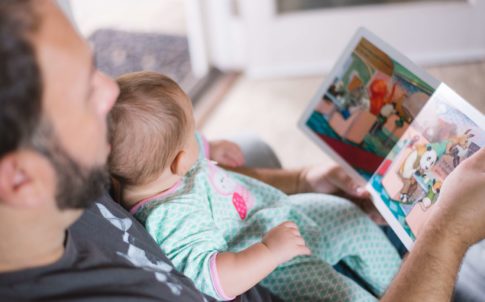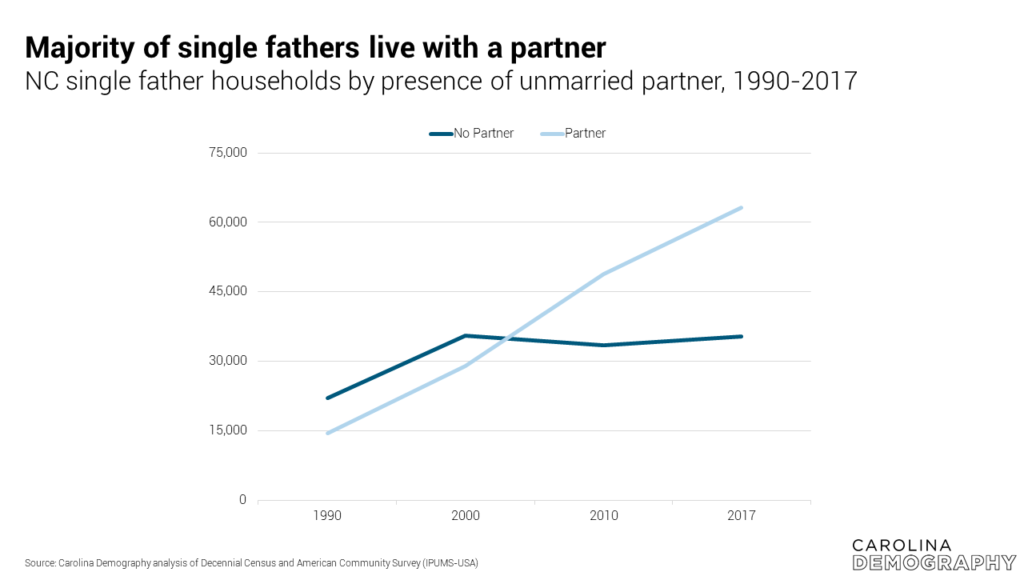A snapshot of single fathers in North Carolina: 2019

Father’s Day will be celebrated on Sunday, June 16, 2019. We’ve compiled some key stats about parenting and fatherhood in North Carolina.
There were 98,434 single father households in NC in 2017, an increase of more than 7,000 since 2016 and the highest number observed since 1960, when just 7,769 households with children were headed by single fathers.
Single father households represented 8.1% of all NC households with children in 2017, the highest share of single father households since 1960, when it was just 1.1%.
In 2017, there were 1.2 million households in North Carolina with at least one child under the age of 18, representing 30.6% all NC households.
This represents a historic low for the share of households with children. In 1960 and 1970, over half of NC households had children—60.2% and 52%, respectively.
This proportion has steadily declined, reflecting the combined impact of longer life expectancy (individuals are living for more years after their children have grown up) as well as declining fertility rates and delayed childbearing.
Among the 1.2 million households with children:
*Single mothers and fathers include individuals who are married but with spouse absent, as well as individuals who have an unmarried partner living in the household.
The remaining 11% of households with children are headed by an individual who is not the mother or father of the child. They may be grandparents or other relatives, and the parents of the child may also be living in the house.
We are limiting our analysis to household heads age 15 and older who have at least one dependent child under the age of 18 living in the household. Children can be biological, adopted, or step sons or daughters.
Fathers who are not the head of the household (or married to the household head) and fathers who do not reside with their children are not included in this analysis.
Note: There were 128,286 NC households in 2017 with children under 18 living in the household headed by an individual who is not the mother or father of the child. They may be grandparents or other relatives, and the parents of the child may also be living in the house.
Single fathers include fathers without a co-resident partner, as well as fathers who are married but their spouse is absent (meaning they live in a separate house) and fathers who are cohabiting with an unmarried partner.
Among the 508,000 NC fathers who were the head were the head of household in 2017, nearly one in five—19%—were single fathers. Some fathers were more likely to be single fathers:

The growth in “single fathers” has been driven by a rising number of fathers who live with an unmarried partner. Between 1990 and 2017, the number of single fathers increased from nearly 36,600 to more than 98,400, an increase of nearly 61,900 or 169% growth.
In 1990, 40% of single fathers were living with an unmarried partner; this proportion had increased 24 percentage points to 64% in 2017.
Young fathers, Black and Latino fathers, fathers without a college degree, and fathers living in or near poverty are more likely to be living with an unmarried partner. As a result, these fathers are more likely to be classified as “single fathers.”
Please let us know if you have other questions that we can address in future blog posts by writing demography@unc.edu. To receive monthly updates about demographic trends in North Carolina, subscribe to our monthly newsletter.
Need help understanding population change and its impacts on your community or business? Carolina Demography offers demographic research tailored to your needs.
Contact us today for a free initial consultation.
Contact UsCategories: Carolina Demographics
Tags: children, family structure, Father's Day, households, single fathers

The Center for Women’s Health Research (CWHR) at the University of North Carolina School of Medicine released the 12th edition of our North Carolina Women’s Health Report Card on May 9, 2022. This document is a progress report on the…

Dr. Krista Perreira is a health economist who studies disparities in health, education, and economic well-being. In collaboration with the Urban Institute, she recently co-led a study funded by the Kate B. Reynolds Foundation to study barriers to access to…

Our material helped the NC Local News Lab Fund better understand and then prioritize their funding to better serve existing and future grant recipients in North Carolina. The North Carolina Local News Lab Fund was established in 2017 to strengthen…
Your support is critical to our mission of measuring, understanding, and predicting population change and its impact. Donate to Carolina Demography today.